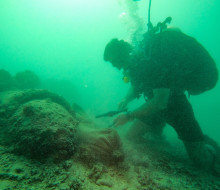
Second World War-era bombs in Vanuatu made safe by Navy divers
26 June 2024
Unfortunately you are viewing this website on an outdated browser which does not support the necessary features for us to provide an adequate experience. Please switch to a modern browser such as latest version of Google Chrome, Mozilla Firefox, Apple Safari or Microsoft Edge.
Ngā mihi nui
Medics in the New Zealand Defence Force (NZDF) can now opt to become fully qualified civilian paramedics, thanks to study pathways offered by the Auckland University of Technology (AUT).
Three Royal New Zealand Navy medics - Leading Medic Laura Salmon, Leading Medic Courtney Davies and Petty Officer Medic Kesia Coutts – juggle part-time study around their Navy duties to achieve their Bachelor of Health Science in Paramedicine from AUT in December.
The trio completed their medic training in 2019 after three years at the Defence Health School at Burnham Military Camp near Christchurch. It’s the longest trade course on offer in the NZDF, and the school has two intakes a year.
Leading Medic Laura Salmon said when they graduated they were military medics but with no civilian qualifications.
“But since then, the school has taken up a pathway with AUT, so we were able to get our training retrospectively recognised through recognition of prior learning.”
They were able to get 14 of the 24 papers required for the Bachelor of Health Science Paramedicine cross credited. They had to complete the remaining 10 papers to get the civilian degree.
“We started studying part time in 2021, doing two papers a semester with the support of our units,” Leading Medic Salmon said.
That had its challenges when they were posted to sea. Those serving as medics on HMNZS Taupo were slightly better off, as the Inshore Patrol Vessel stayed close to shore and got better reception.
“In our final semester we had to conduct various ambulance shifts. We were given days off as study leave so we did not have to use our annual leave for our studies. These ambulance shifts were a highlight as it gave us great exposure to many of the emergency medical conditions the Navy has trained us in, but aren’t as common in the Navy environment.”
Leading Medic Salmon said staff at AUT were very supportive.
“They understood we were in the military and sometimes the Navy had to come first. They extended deadlines if we were away, changed exam dates to suit and let us conduct some exams on base so we didn’t have to travel out to campus.”
She said while it was challenging to fit in their full-time roles as medics with part-time study, it was worth it.
“It has been great learning and professional development.”
Staff Sergeant Kelly Whittle, Senior Instructor Defence Health School, said the new pathway with AUT now included 18 months of AUT study at Burnham, with AUT lecturers based at the school.
Medics can now obtain a Diploma in Paramedic Science, then a Graduate Certificate in Health Science. It means the training programme has been cut down from three years to two.
“They will have more than enough training and background to be an NZDF medic, but the degree is a great option if they are interested in further study. They have approximately five years to complete it once enrolled,” Staff Sergeant Whittle said.